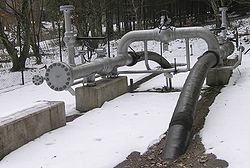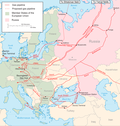Pipeline
A pipeline is a long tube, that is used to transport liquids or gases over long distances. Pipelines are made of metal. While the transport of liquids and gases is common, some pipelines are used to transport coal or iron ore, which are mixed with mud. Such pipelines are sometimes called slurry pipelines. Even though a pipeline is very expensive to build, the low operating cost often makes it the cheapest transport.
Many stadiums use a central tank for beer. Each bar is served by a pipeline from the central tank.
Even though mail and other goods can also be delivered that way, the system is generally not referred to as pipeline. In this case, capsules are used. These are propelled by air.
Technology
Pipeline networks are made of different components. These are:
- The supply station is where the pipeline starts. Very often, there are tanks that act as a buffer
- There are several pumps and compressors, which move the product through the pipeline.
- Partial delivery stations allow to deliver part of the product
- Block valve stations use valves to isolate the pipeline into independent segments.
- Regulator stations are used to release some of the pressure
- The final delivery station is where the product is delivered to the consumer. Very often tanks are used as a buffer.
Images
A pipeline in Portugal
A pipeline used for a hydroelectric power plant, in Germany
Pipeline Media
HDPE pipeline on a mine site in Australia
A "Pig" launcher/receiver, on the natural gas pipeline in Switzerland
An elevated section of the Trans-Alaska Pipeline System
Major Russian gas pipelines to Europe in 2009.[needs update] Deliveries on some pipelines were disrupted by or became controversial after the 2022 Russian invasion of Ukraine, including the 2022 Russia–European Union gas dispute.
The world's longest ammonia pipeline, from Russia to Ukraine
Thor Pipeline in Randers, Denmark












